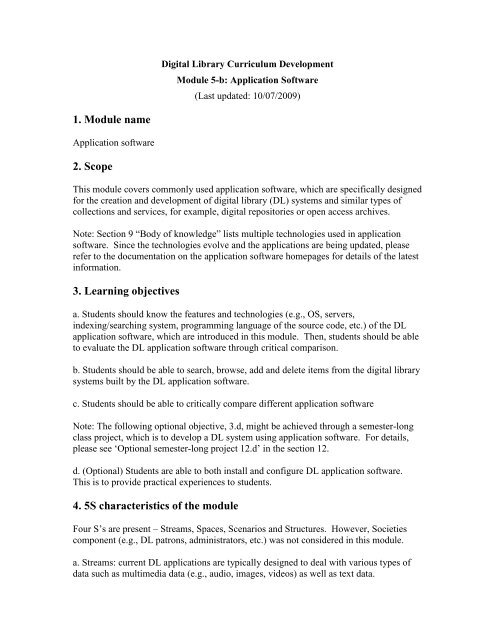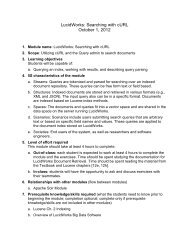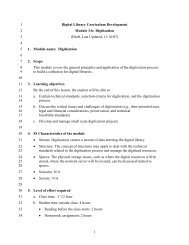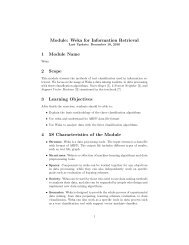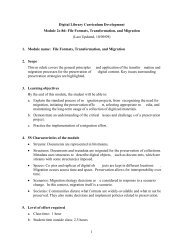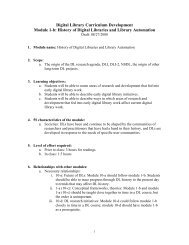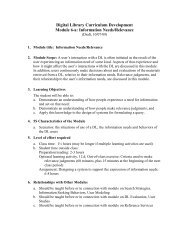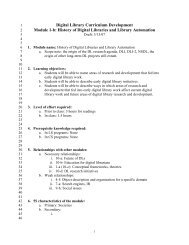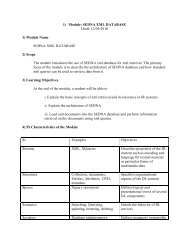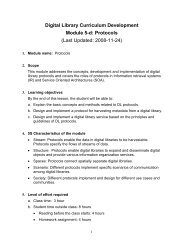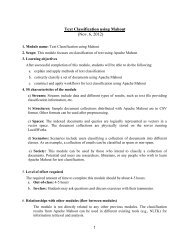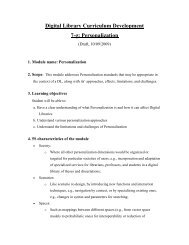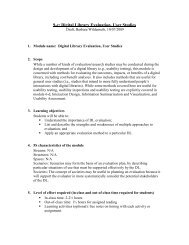1. Module name 2. Scope 3. Learning objectives 4. 5S ...
1. Module name 2. Scope 3. Learning objectives 4. 5S ...
1. Module name 2. Scope 3. Learning objectives 4. 5S ...
- No tags were found...
Create successful ePaper yourself
Turn your PDF publications into a flip-book with our unique Google optimized e-Paper software.
Digital Library Curriculum Development<strong>Module</strong> 5-b: Application Software(Last updated: 10/07/2009)<strong>1.</strong> <strong>Module</strong> <strong>name</strong>Application software<strong>2.</strong> <strong>Scope</strong>This module covers commonly used application software, which are specifically designedfor the creation and development of digital library (DL) systems and similar types ofcollections and services, for example, digital repositories or open access archives.Note: Section 9 ―Body of knowledge‖ lists multiple technologies used in applicationsoftware. Since the technologies evolve and the applications are being updated, pleaserefer to the documentation on the application software homepages for details of the latestinformation.<strong>3.</strong> <strong>Learning</strong> <strong>objectives</strong>a. Students should know the features and technologies (e.g., OS, servers,indexing/searching system, programming language of the source code, etc.) of the DLapplication software, which are introduced in this module. Then, students should be ableto evaluate the DL application software through critical comparison.b. Students should be able to search, browse, add and delete items from the digital librarysystems built by the DL application software.c. Students should be able to critically compare different application softwareNote: The following optional objective, <strong>3.</strong>d, might be achieved through a semester-longclass project, which is to develop a DL system using application software. For details,please see ‗Optional semester-long project 1<strong>2.</strong>d‘ in the section 1<strong>2.</strong>d. (Optional) Students are able to both install and configure DL application software.This is to provide practical experiences to students.<strong>4.</strong> <strong>5S</strong> characteristics of the moduleFour S‘s are present – Streams, Spaces, Scenarios and Structures. However, Societiescomponent (e.g., DL patrons, administrators, etc.) was not considered in this module.a. Streams: current DL applications are typically designed to deal with various types ofdata such as multimedia data (e.g., audio, images, videos) as well as text data.
. Research institutions use it to build various digital archives forinstitutional repositories, learning object repositories, digital preservation,publishing, etc.c. Open source under BSD licensed. A list of repositories using DSpace can be found at:http://www.dspace.org/index.php?option=com_content&task=view&id=596e. Or visit the Electronic Theses and Dissertations (ETD) repository in theUniversity of North Carolina at Chapel Hill athttp://etd.ils.unc.edu/dspace/ for a specific example<strong>2.</strong> Featuresa. Long-term preservation supportedi. There are three types of data formats (supported, known andunsupported types)ii. For all three types, DSpace does bit preservation: the preserved fileremains exactly the same over time – not a single bit is changediii. For supported types, DSpace does functional preservation: the filechanges over time so that the material can be immediately usablein the same way it was originally, while the physical media anddigital formats changeb. Interoperabilityi. It can export digital content with its metadata in an XML-encodedfile or METSii. DSpace Java API can be customized to allow interoperation withother systemsiii. Handle System from CNRI is assigned to each digital item as apersistent identifierc. Support for Open Archives Initiative‘s Protocol for Metadata Harvesting(OAI-PMH)i. DSpace supports OAI-PMH v.<strong>2.</strong>0 as a data providerii. OAI support was implemented using OCLC‘s OAICatiii. Institutions running DSpace can turn on and off OAI and choose toregister as a data provider or not<strong>3.</strong> Content typesa. Textb. Multimedia (image, audio, video)<strong>4.</strong> Standardsa. Well-defined APIs for interoperability with other systemsb. CNRI handles for persistent identifiersc. X.509 certificate-based access controld. Dublin Core metadata for digital objectse. OAI-PMH for metadata harvesting/providingf. METS profile can be used to export digital items5. Technologies useda. Operating system: Linux, Solaris, HP/UX, etc.b. Server: Apache, Tomcat, OpenSSL
Topic: Greenstonec. Indexing/searching: Lucened. Database system: PostgreSQL, JDBCe. CNRI Handle Systemf. Jena (RDF history system)g. Java, JSP, Servletsh. JUnit (testing) and Log4j(logging)<strong>1.</strong> Overviewa. It was developed and distributed as an international cooperative effortestablished in 2000 by the University of Waikato with UNESCO andHuman Info NGO, ―New Zealand Digital Library Project.‖b. It helps the universities, libraries and public service institutions build theirown digital libraries.c. It is a suite of software that has ability to build new digital librarycollections and provide services for them.d. Open source under General Public License (GPL)e. A list of systems using Greenstone is at:http://www.greenstone.org/examplesf. Or visit Oxford Digital Library at http://www<strong>2.</strong>odl.ox.ac.uk/gsdl/cgibin/library/for a specific example<strong>2.</strong> Featuresa. Installation of Greenstone digital library (GSDL)i. It runs on Windows, Unix/Linux, and Mac OS/X. It can beinstalled easily by using the ready-to-use binaries which areincluded in the distribution (but some functionality is limited).ii. It might be installed on a laptop for personal use (built-in webserver), or run on the main web server (Apache or Windows IIS).b. Collection buildingi. It can harvest documents over OAI-PMH to include them in acollectionii. Full text tagging is supported for hierarchical document browsingiii. Automatic text extraction and indexing are providediv. Data compression is supportedv. Metadata<strong>1.</strong> Automatic extraction of simple metadata<strong>2.</strong> Explicit metadata via classifiers<strong>3.</strong> Used for browsing and searchingvi. Multiple languages supported via Unicodec. Browse and search providedi. Full text searchii. Metadata field searchiii. Either Boolean or ranked (when indexed with MG indexer)iv. Search history, search term highlighting, etc.d. Presentation
i. Search results formatting availableii. Homepage customization availablee. Collection administrationi. Adding new documents (batch operation)ii. Usage monitoringiii. Securityf. Interoperabilityi. Any Greenstone collection can be exported to DSpaceii. Any DSpace collection can be imported into Greenstoneiii. Any collection can be exported to METS (in the Greenstone METSProfile) and Greenstone can ingest documents in METS formg. Customizable, extensiblei. New document and metadata formats can be accommodated bywriting ‗plug-ins‘ in Perlii. New metadata browsing structures can be implemented by writing‗classifiers.‘iii. User interface can be customized using ‗macros‘ written in asimple macro languageiv. CORBA protocol allows agents (e.g., written in Java) to use all thefacilities associated with document collections<strong>3.</strong> Architecturea. Receptionisti. Provide user interfaceii. User input acceptediii. Page generationiv. Send to appropriate collection serverb. Collection serveri. Collection content managementii. Search/filter informationiii. Return resultsiv. Handle multiple collectionsc. Metadata supplied by communities<strong>4.</strong> Content typesa. Textb. Multimedia (image, audio, video)5. Standardsa. Dublin Core metadata for digital itemsb. Z39.50 client-server protocol for searching and retrieving informationfrom remote computer databases.c. Support for OAI-PMH both as a client and a serverd. Unicode for multiple language support6. Technologies useda. Greenstone runs on all versions of Windows and Unix/Linux and Mac OS-X.b. Apache HTTP server
c. Source code in C++ (experimental Greenstone v.3 is written in Java) andPerl availabled. Greenstone provides a choice of three indexing toolsi. MG is the default indexer. It does section level indexing and thesearches can be either Boolean or ranked. For phrase searching,Greenstone does ‗AND‘ search on all the terms.ii. MGPP (MG plus plus, new version of MG). It does word levelindexing, which provides fielded, phrase and proximity searching.Boolean searches can be ranked. Document/section levels andtext/metadata fields are all handled by the one index. It‘s a bitslower compared to MG when large data is to be indexedconsidering MGPP does word level indexing.iii. Lucene was added for incremental collection building, whichcannot be provided by MG and MGPP. It handles field andproximity searching but only at a single level for example,complete documents or individual sections but not both. It alsoprovides single-character wildcards and range searching.e. Multiple GNU software are integratedi. Apache web serverii. Perliii. wget to download pages from the webiv. XML::Parser used to read and write internal XML documentsv. Stemmer for English documentsvi. CVS for version controlvii. GDBM for databaseviii. and many moreTopic: CONTENTdm<strong>1.</strong> Overviewa. It was conceived by the Center for Information Systems Optimization(CISO) at the University of Washington. It was then taken over andextended by the Online Computer Library Center (OCLC).b. It is commercial software.c. Its users are universities, public libraries, government entities, museums,non-profit organizations, etc.d. It is 100 percent web compatible so the servers and collections can beadministered remotely. There could be a maximum of 50 ‗acquisitionstations‘, which are remote locations for items and their metadata entry.Those data entered through the acquisition stations are stored and providedby the central CONTENTdm server.e. Collection sharing is supported.
i. Collections can be added to OCLC WorldCat catalog system sothat the user collections can be part of WorldCat‘s 80 millionrecord global catalog.ii. CONTENTdm functions as OAI data repositories for the userswho want their metadata available for harvesting.iii. Its Multi-Site Server allows users to query multipleCONTENTdm servers from a single user interface.f. Example collections can be browsed athttp://www.oclc.org/contentdm/collections/g. Or visit the Virginia Commonwealth Univ.‘s PS Magazine, the PreventiveMaintenance Monthly collection athttp://dig.library.vcu.edu/cdm4/index_psm.php?CISOROOT=/psm<strong>2.</strong> Features (based on http://www.oclc.org/contentdm/about/default.htm)a. It supports both text documents and multimedia. For example, it buildsdocuments, books and other multiview and multipage materials. It can alsopresent video and audio files with related transcripts.b. By using the batch import tools, it can import images and metadataquickly and easily as well as text files for full-text searching.c. By utilizing the compound object import wizard, CONTENTdm canimport multiple compound objects, such as newspapers, in batches. I alsocan queue multiple compound objects and process them during off-hoursto not slowdown the system use.d. It supports JPEG2000, which is a format for high-quality and large formatimages without a browser plug-in.e. To prevent unwanted copying of images it manages, CONTENTdm hasthree different options for image rights: band, brand or watermark. Banduses a band of color and words (in here, a ‗band‘ means a layer in a digitalimage. The term originally came from electrical engineering field torepresent a range of wavelengths or colors). Brand uses icons and words.Watermark uses grayscale images.f. For digitized text documents, CONTENTdm provides an integratedOptical Character Recognition (OCR) capability for full-text searching.Users will be able to search words in the digitized text in addition tosearchable metadata fields within your collections. When viewed, itemsprepared with this feature will display highlighted search terms within thedigitized document image.g. To index subjects of various still images (so that they can have consistentand uniform metadata), CONTENTdm uses the Library of CongressThesaurus for Graphical Materials I (TGM I), which provides acontrolled vocabulary to describe activities, objects, types of people,events or places. Proper noun <strong>name</strong>s of those are excluded. As an option,you can develop your own controlled vocabulary to index images.
h. It provides customizable user interfaces—Create predefined queries andcustomized interfaces to collections.i. Its flexible search features include Dublin Core and Latin-1 character setsupport, Boolean search and advanced search option. Advanced searchoption provides search-by-fields, across all fields, by proximity, andacross one or many collections. CONTENTdm also auto-generates thesearch terms based on the existing metadata.<strong>3.</strong> Content typesa. Textb. Multimedia (e.g., image, video, audio)c. Compound objects (items which consist of multiple views. For example,two-sided objects such as postcards, brochures, ticket stubs, or six-sidedobjects such as images of a chair seen from six different directions)a. CONTENTdm allows the users to define compound objects so thatall the views of a compound object can be retrieved.d. Null data type support for the items not yet in the systeme. URL data type support allows lengthy video and audio files stored in thestreaming media server to be accessed through CONTENTdm.<strong>4.</strong> Standards and technologiesa. CONTENTdm is fully compliant with OAI-PMH v.<strong>2.</strong>b. Its default metadata templates are Dublin Core and Visual ResourceAssociation (VRA) Core. Collection admins can still add their owndescriptions.c. It is Z39.50 (client-server protocol to access and retrieve information inremote computers) compatible through ZCONTENT, open sourcesoftware developed by the Univ. of Utah Marriott Library. ZCONTENTallows users to access the collections of CONTENTdm and downloaditems.d. XML is used for all the internal structure description. For example, it isused to export the metadata descriptions in order to work with othersystems that have different metadata standard.(Optional) Topic: Critical Comparison of the DL application softwareBased on the resources in the next section 10. Resources (especially ‗Comparingthe DL application software‘), a comparison table can be built to show thesimilarities and differences of the DL application software. This will providestudents with ability to think critically when they need to select DL applicationsoftware to set up a DL.10. Resources
Note: Feel free to read about features, technologies and (optionally) installation andconfiguration manuals as well as the assigned portion in the software homepages.• Eprints 3o Reading for students• Read ‗Introducing EPrints 3‘ and watch short QuickTime videoclips at http://www.eprints.org/software/v3/• DSpaceo Reading for students• Visit DSpace homepage at http://www.dspace.org/ and read‗About DSpace‘ under ‗New to DSpace?‘ on the top left pane.o Advanced reading for students (optional) and instructors• DSpace architecture review group, ―Toward the next generation:Recommendations for the next DSpace Architecture‖, January 24,2007. http://wiki.dspace.org/static_files/0/0e/DSpace-recs.pdf• Greenstoneo Readings for students• Ian H. Witten and David Bainbridge, A brief history of theGreenstone Digital Library Software, athttp://wiki.greenstone.org/wiki/gsdoc/others/Greenstone_history.htm• Katherine J. Don, David Bainbridge, and Ian H. Witten, Thedesign of Greenstone 3: An agent based dynamic digital library, athttp://www.greenstone.org/docs/greenstone3/gs3design.pdfo Advanced readings for students (optional) and instructors• Ian H. Witten and David Bainbridge. (2003). How to build a digitallibrary. Morgan Kaufmann.• CONTENTdmo Readings for students• Visit http://www.oclc.org/contentdm/about/default.htm and readthe topics under ‗About‘ on the left pane.• Comparing the DL application softwareo Readings for students• Witten, I. H., Bainbridge, D., Tansley, R., Huang, C. & Don, K. J.(2005). StoneD: A Bridge between Greenstone and DSpace. D-LibMagazine, 11(9).http://www.dlib.org/dlib/september05/witten/09witten.html• Wang, J. Y., Assion, M. & Matthaei, B. (2003). Open ArchivesForum: Inventories-Open Archives Software Tools.http://www.oaforum.org/otherfiles/tv-tools.pdf• William Nixon. DAEDALUS: Initial experiences with EPrints andDSpace at the University of Glasgow. Article is inhttp://www.ariadne.ac.uk/issue37/nixon/• Goh, D. H.-L., Chua, A., Khoo, D. A., Khoo, E. B.-H., Mak, E. B.-T., & Ng, M. W.-M. (2006). A checklist for evaluating open source
digital library software. Online Information Review, 30(4), 360-379. http://dx.doi.org/10.1108/146845206106862831<strong>1.</strong> Concept maps (created by students)After studying the material in this module, students will create a concept map, whichrepresents the concepts in the module and their relationships with one another. Bytransforming the knowledge in their mind into a graphical representation, students willhave a ‗clearer picture‘ of the content.Students might create concept maps not only for the content in the body of knowledgesection, but also for the learning activities section. For example, students may show thesteps to search, browse, add, delete, import or export an item in a concept map. Or, theycan list features of different DL application software and compare them to promotecritical thinking. Even a concept map (or multiple concept maps) can be created for thesemester-long DL development project, showing several phases of the project such aspreparation step, actual installation and configuration of the software, content selection,collection development, etc.Note: IHMC Cmap Tools is an open source client tool to create concept maps.CmapServer enables the users to collaborate and share concept maps anywhere on theinternet. Both software can be downloaded freely for educational purposes fromhttp://cmap.ihmc.us/download/index.php1<strong>2.</strong> Exercises / <strong>Learning</strong> activitiesa-<strong>1.</strong> Group presentations on specific DL application softwareNote: These group presentations will substitute for a formal lecture by the instructor. Theinstructor should be prepared to fill in gaps or make corrections if any of thepresentations are incomplete or misleading.o During the previous class, students form into groups. Each group chooses aparticular DL application software for their group presentation. Readings areassigned from the Resources list in section 10. Instructors may provide guidelinessuch as what to address and time limits for each group presentation.o The students in a group should work together to create their presentation slidesexplaining the features and other information of the software such as services,technologies and standards used.o In the class, each group gives a presentation about their application softwarefollowed by a question and answer session. Each presentation should be donewithin a time limit given by the instructors.
a-<strong>2.</strong> Writing a short white paper on specific DL application software (suggested by BobAllen, iSchool at Drexel)Note: This individual activity may be used instead of a-1: Group presentation activity.This exercise can provide details of the DL application software to students. Instructorsshould select appropriate class activity based on the students‘ learning styles.o The instructor assigns (or each student selects) a topic (e.g., one of DL applicationsoftware) and write a short white paper about it.o The instructor reviews students‘ white papers for accuracy and provide necessarycomments to students.o Students revise their white paper based on the instructor‘s comments and resubmitsit.o The instructor makes the white papers available to all students by posting them tothe class website so that the papers could be used as resources.b. Individual learning activity: Interacting with software demosPrior to the class session, each student should complete the following activities. Studentsmay work individually or together.o (EPrints demo) Try searching and browsing. You need to create an account if youwant to try depositing an item. Examine the metadata fields when you enter themetadata while depositing an item.• Demo site at http://demoprints<strong>3.</strong>eprints.orgo (DSpace demo) Interactive demo for students• Learn how to submit an item at http://libraries.mit.edu/dspacemit/build/dspace-demo.html• Try searching and browsing at http://dspace.mit.edu/o (Greenstone demo)• Demo page for searching for an item at http://diglib.auburn.edu/gsdlr/cgibin/library?site=localhost&a=p&p=about&c=demo&ct=0&l=en&w=utf-8o (CONTENTdm) Watch the four minute tour video clip at• http://www.oclc.org/contentdm/tour/tour.htmc. Scenario-based application software selection (prior to this exercise, please read thepapers under 10.Resources Comparing the DL application software)In this exercise, three scenarios are given. For each scenario, your job is to select themost appropriate digital library (DL) application software, which might satisfy therequirements described in the scenario. In addition, you need to provide your reasons todo that.In case students have diverse opinions about the software selection, there will be a classdebate to resolve the issues.
o Scenario 1:As a member of an NGO, Susan has been working with indigenous people incountry X, which is one of the third world countries. This tribe has a uniquewood carving techniques using hand tools and a variety of traditional songs thatare sung when they work together to make a huge sculpture. These techniquesand songs have been passed down from generation to generation until recently.However, things have been changed significantly. Younger generation is notinterested in learning the wood carving techniques and songs anymore. To them,movies and rock music are new and much more fun culture. But the chief of thetribe and older generation realize the importance of preserving their uniqueculture, so they consulted Susan to develop a local digital library. She has abackground in Library and Information Science and could educate people aboutthe basics of librarianship.With the help of the tribe, Susan could take pictures of the wood artifacts. Shealso collected traditional songs using a digital recorder. Since the data is prepared,the next step is to set up a digital library system on a computer. But, the problemis that there is no internet connectivity in that region. There are some computersfor educational purposes, but they are old, 386-processor computers. Consideringthe situation in this village, what kind of digital library application softwareshould Susan choose? And why?o Scenario 2:The professors in the school of engineering at Y Tech are very active in theirresearch projects. Every year, they and their graduate students publish variousjournal articles, conference proceeding papers, posters, demos, as well asexperimental program codes. The dean made a decision to set up a centralrepository to collect all those published materials for internal use (and possiblyopen to public in the future).She puts much emphasis on the ‗preservation‘ of the resources in this repositorybecause there are foundational theories developed and published in this school,whose access should be guaranteed even after several decades. In addition,scholars should be able to access this repository on the internet. Since this systemis used by faculty members and graduate students themselves, the process ofsubmission should be simple and does not require knowledge of a librarian. Toset up this central repository, the school recently purchased a computer, which isequipped with quad-core processors, internet connectivity and a Linux operatingsystem. Which digital library application software should be selected to set up arepository in this school? Please provide your reasons, too.o Scenario 3:A research institution, S, produces tons of text-based content such as peerreviewedjournal articles, theses and dissertations as well as some multimediacontent such as data sets, images from experiments, lecture video clips and audio
files. In addition, the institution plans to import educational resources in a coupleof months later from other institutions. Those materials need to be preserved fora long period of time considering their values.Therefore, a project was set up to establish an institutional repository, whichwould hold the content mentioned above (mostly text-based material). Theprincipal investigators of the project made a list of requirements that should besatisfied by the repository. They are as follows:Students and faculty members should be able to easily deposit and managetheir submitted content such as theses, dissertations, lecture slides, lecturevideo notes, or audio data filesThe administrator‘s user interface in the repository software should supporteasy maintenance of the repository software settingsThe repository software should be OAI-compliantThe repository software should support a type of educational material elementset (e.g., SCORM).Which application software will be appropriate in this institution? EPrints?DSpace? CONTENTdm? Or would it be better to create two repositories usingthe different application software then connect the two repositories seamlessly? Ifyou were one of the principal investigators, what would you say in the PI meeting?Please provide your reasons to choose the software.d. Optional semester-long project (group activity)o Step 1: Students form a group and meet with clients who want to have acustomized DL system developed.o Step 2: The clients give the student groups specifications of the DL systems theywant.o Step 3: Each student group explores different DL application software to find themost appropriate application to meet their client‘s needs.o Step 4: Student group installs the application software chosen in step 3, includinginstallation of any pre-requisite software. For example, to install EPrints 3 in alinux machine, the Perl programming language along with its multiple modules,MySQL database and Apache server should also be installed in advance.o Step 5: The installed application software is customized. For example, thestudents might configure the subject classification system as the Library ofCongress (LOC) system or ACM classification, change the appearance of the userinterface, modify the metadata fields used, etc.o Step 6: The client verifies whether the installed DL application software isappropriately configured to meet his/her needs.
o Step 7: Student groups begin to create collections by adding the items provided bytheir clients to develop a DL (e.g., adding a group of pictures to create the DigitalLibrary of Native American History or the Virginia Digital Museum of Cars, etc.).o Step 8: Student group members make sure all the services of the developed DLsystem work well.o Step 9: Clients evaluate the developed DL system and the student group refines itbased on the feedback.1<strong>3.</strong> Evaluation of learning objective achievementNote: Since the learning <strong>objectives</strong> and the learning activities are in one-to-one mappingrelationships, the performance and the quality of the learning activities achievements areevaluated as the means to evaluate the learning <strong>objectives</strong> of this module.a. Group presentations on specific application softwareThe group presentations described in section 12 could be graded, to evaluate students‘learning.o Group presentations might be evaluated in terms of their comprehensiveness (didthey include the important features and characteristics of the software?), theirclarity (did they explain the software in a way that it could be distinguished fromthe alternative software packages?), and the quality of the presentation (e.g., slidequality, presentation style, use of time, and Q/A session).b. Individual concept maps on specific application softwareo After the class, each individual student creates one or more concept maps for thedifferent application software packages and submits them to the instructor. Theconcepts maps are expected to demonstrate the student‘s overall understanding ofall four software packages introduced in this module.o The concept maps should be evaluated in terms of their comprehensiveness (didthey include all the major concepts covered in the module?), their richness (werethe concepts well-connected?), and their organization (was there a clear depictionof the concepts and their relationships?).c. After reading each of three scenarios, students will answer the questions at the end ofeach scenario and participate in the class discussion. Instructors will assign points basedon the participation and the clarity of the reasons.d. (Optional) semester-long projecto Each instructor may develop a different method for evaluating the learningachieved through this project. We suggest that points might be assigned asfollows:
1<strong>4.</strong> Glossary• The DL application software is incorrectly installed and not working (0points)• DL application software as well as all the pre-requisite software iscorrectly installed (3 points)• DL application software is installed and fully configured (6 points)• The DL system is fully configured and a collection(s) is created with thedata provided by the clients (10 points)• All the features of the new DL system are fully functional (15 points)Application software is a complete, self-contained program that performs aspecific function directly for the user. This is in contrast to system software suchas the operating system kernel, server processes, libraries which exists to supportapplication programs and utility programs. – Dictionary of Computing –API (Application Programming Interface) The interface (calling conventions)by which an application program accesses operating system and other services.An API is defined at source code level and provides a level of abstraction betweenthe application and the kernel (or other privileged utilities) to ensure theportability of the code. An API can also provide an interface between a high levellanguage and lower level utilities and services which were written withoutconsideration for the calling conventions supported by compiled languages. Inthis case, the API's main task may be the translation of parameter lists from oneformat to another and the interpretation of call-by-value and call-by-referencearguments in one or both directions. – Free On-Line Dictionary Of Computing –CORBA is the acronym for Common Object Request Broker Architecture,OMG‘s open, vendor-independent architecture and infrastructure that computerapplications use to work together over networks. Using the standard protocolIIOP, two application programs that are based on CORBA but developed bydifferent vendors, on different operating systems, programming languages caninteroperate with each other. – Object Management Group (OMG) –OpenURL is a type of URL that contains resource metadata for use primarily inlibraries. The National Information Standards Organization (NISO), hasdeveloped OpenURL and its data container (the ContextObject) as internationalANSI standard Z39.88. On 22 June 2006, OCLC was <strong>name</strong>d the maintenanceagency for the standard.Dublin Core metadata element set is a standard for cross-domain informationresource description. It provides a simple and standardized set of conventions fordescribing things online in ways that make them easier to find. Dublin Core iswidely used to describe digital materials such as video, sound, image, text, andcomposite media like web pages. Implementations of Dublin Core typically make
use of XML and are Resource Description Framework based. Dublin Core isdefined by NISO Standard Z39.85-2007Z39.50 is a client-server protocol for searching and retrieving information fromremote computer databases. It is covered by ANSI/NISO standard Z39.50, andISO standard 23950. The standard's maintenance agency is the Library ofCongress. Z39.50 is widely used in library environments and is often incorporatedinto integrated library systems and personal Bibliographic Reference software.Interlibrary catalogue searches for interlibrary loan are often implemented withZ39.50 queries.OAI-PMH (Open Archives Initiative Protocol for Metadata Harvesting) is aprotocol developed by the Open Archives Initiative. It is used to harvest (orcollect) the metadata descriptions of the records in an archive so that services canbe built using metadata from many archives.XML (Extensible Markup Language) is a general-purpose markup language. Itis classified as an extensible language because it allows its users to define theirown tags. Its primary purpose is to facilitate the sharing of structured data acrossdifferent information systems, particularly via the Internet.SOAP (Service Oriented Architecture Protocol) is a protocol for exchangingXML-based messages over computer networks, normally using HTTP/HTTPS.SOAP forms the foundation layer of the Web services stack, providing a basicmessaging framework that more abstract layer can build on.15. Additional useful links16. ContributorsSeungwon Yang (Virginia Tech, development), Edward A. Fox (Virginia Tech,evaluation), Eunyee Koh (Texas A&M, evaluation), Uma Murthy (Virginia Tech,evaluation), Jeff Pomerantz (UNC, evaluation), Sanghee Oh (UNC, evaluation), BarbaraWildemuth (UNC, evaluation), Robert B. Allen (iSchool at Drexel, evaluation), Sally JoCunningham (Univ. of Waikato, evaluation)


